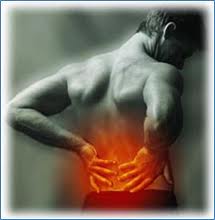Feel (and Think) Don't Force.
Learn to 'feel and think but not force' into each pose, use your breath to soften into a stretch instead of tensing and forcing it. Also become conscious of what emotions and thoughts bubble to the surface and try to be okay with those feelings and thoughts as you anchor to your breath and let them wax and wane.

Recently I have had some issues with my right shoulder blade and rib cage. After a treatment from a student and masseuse, she recommended I see an Osteopath for further assessment. This Osteopath noticed I had slight scoliosis which had been pointed out to me when I was a teenager but no treatment was issued way back then. He suggested that the mild scoliosis and over loading of my upper body muscles through a strong and repetitive Vinyasa practice had affected my ribcage region. A few of my ribs were immobile when I breathed (apparently not a normal thing) and on later consultation it was noticed that my ribs were tethered to my diaphragm. This was loosened through body-work, a reduction in the Sun Salutations, easing off twists and backbends for a couple of weeks, lots of pranayama and focus on greater awareness during my practice.
I was also aware that many teachers and regular practitioners need to be extra careful to practice with symmetry and be aware if one side of the body can twist with more ease than the other, and if one side can stretch further that the other; because if we just glide into these comfortable and familiar nuances we are setting ourselves up for possible injury and imbalance.
It can be difficult to judge this however when you have had an irregularity in the spine for an extended amount of time as I had with the mild scoliosis (from teen years), so what perhaps should feel like an over toning on one side and over stretching on the other actually can feel normal in this circumstance. If you become aware of an imbalance in your body or in my case (mild scoliosis) you may not be able to rely on the feel not force mantra, you may need to really focus in deeper and picture in your mind the imbalance that you may not feel. Once you know which side possibly twists more than the other (a professional: chiropracter, spinologist, osteopath or physiotherapist can help) you can mindfully practice from that place, perhaps stopping a twist earlier than your body feels it requires and enjoying a longer stretch or twist on the opposite side.
I believe I have quite a good grasp of body awareness, having danced from age 4 to 24 and then for years afterwards continuing with some form of basic body work whilst raising children. The last ten years I have been either practicing and/or teaching yoga. Yet, with all of this day-to-day awareness and knowledge here I am (hopefully) momentarily adrift in a wave of breath shortness and rib/shoulder blade pulling, wondering what was this new nasty sensation and dis-ease I was feeling.
The article below is one I had copied some time ago and is a helpful reminder of how to practice and perhaps an indication of what may be going on in your body. I don’t remember where it came from (possibly Yoga Journal?) but I hope it may be of benefit not just to me, but to others.
“The opposite of feeling is forcing. When we force, we cannot feel, and when we feel, we cannot force. If we force ourselves into poses especially twists, the spine will twist where it always has, where it needs the twist least.
When we feel through the pose, we can sense which vertebrae are twisting and which are not. This way we allow movement where there was stagnation, release where there was stiffness, and freedom where there was bondage.
Take the time to try poses from feeling rather than forcing, you will build even strength and flexibility that way and ward off injury. If you notice one side twists easier than the other, sometimes it’s a good idea to hold back on that side (rather than over stretching it) and work on the other less flexible side. In each asana, you can find an inner awareness that leads to peace in your heart.” ~ unknown.
Other Quotes:
- "Yoga is not about touching your toes, it's about what you learn on the way down..." ~ Dr. Judith Lasater.
- "Our patience will achieve more than our force." ~ Edmund Burke.
This was used as the Spirit Yoga Theme for the week, I hope it can guide you to practice from feel and/or thought not force!




